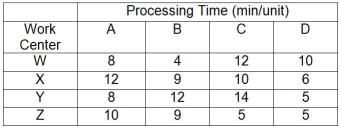Multiple Choice
Table 7.7
A company makes four products that have the following characteristics: Product A sells for $75 but needs $20 of materials and $20 of labor to produce;Product B sells for $90 but needs $45 of materials and $20 of labor to produce;Product C sells for $110 but needs $50 of materials and $30 of labor to produce;Product D sells for $135 but needs $75 of materials and $40 of labor to produce.The processing requirements for each product on each of the four machines are shown in the table.  Work centers W,X,Y,and Z are available for 40 hours per week and have no setup time when switching between products.Market demand is 50 As,60 Bs,70 Cs,and 80 Ds per week.In the questions that follow,the traditional method refers to maximizing the contribution margin per unit for each product,and the bottleneck method refers to maximizing the contribution margin per minute at the bottleneck for each product.
Work centers W,X,Y,and Z are available for 40 hours per week and have no setup time when switching between products.Market demand is 50 As,60 Bs,70 Cs,and 80 Ds per week.In the questions that follow,the traditional method refers to maximizing the contribution margin per unit for each product,and the bottleneck method refers to maximizing the contribution margin per minute at the bottleneck for each product.
-Use the information in Table 7.7.Using the bottleneck method,what is the profit if the company manufactures the optimal product mix (consider variable costs only-overhead is not included in this profit calculation) ?
A) less than or equal to $6,500
B) greater than $6,500 but less than or equal to $6,700
C) greater than $6,700 but less than or equal to $6,900
D) greater than $6,900
Correct Answer:

Verified
Correct Answer:
Verified
Q4: How can Theory of Constraints principles be
Q7: Table 7.12<br>A company desires to set up
Q8: Table 7.14<br>The production of a particular product
Q13: The process batch at the constraint in
Q13: Table 7.4 <img src="https://d2lvgg3v3hfg70.cloudfront.net/TB2904/.jpg" alt="Table 7.4
Q14: A business school with plenty of classroom
Q16: Table 7.7<br>A company makes four products that
Q17: There are three consecutive steps in a
Q56: Variability of a firm's workload may create
Q92: A line balance that is 100% efficient